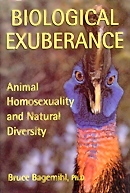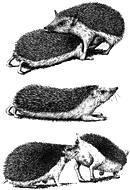
Gay/Lesbian/Feminist Bookstores Around the Country
The Mostly Unfabulous Homepage of Ethan Green
![]()


The Perversion of Scientific Discourse
From Biological Exuberance
In many ways, the treatment of animal homosexuality in the scientific discourse has closely paralleled the discussion of human homosexuality in society at large. Homosexuality in both animals and people has been considered, at various times, to be a pathological conditions; a social aberrations; an "immoral," "sinful," or "criminal" perversion; an artificial product of confinement or the unavailability of the opposite sex; a reversal or "inversion" or heterosexual "roles"; a "phase" that younger animals go through on the path to heterosexuality; an imperfect imitation of heterosexuality; an exceptional but unimportant activity; a useless and puzzling curiosity. And a functional behavior that "stimulates" or "contributes to" heterosexuality.
 |
| Courtship and sexual activity between female Long-eared Hedgehogs: sliding (above), arching posture (middle), and cunnilingus Illustration by John Megahan, © 1999. |
The entire history of ideas about, and attitudes toward, homosexuality is encapsulated in the titles of zoological articles (or book chapters) on the subject through the ages: "Sexual Perversion in Male Beetles" (1896), "Sexual Inversion in Animals" (1908), "Disturbances of the Sexual Sense [in Baboons]) (1922), "Pseudomale Behavior in a Female Bengalee [a domesticated finch] (1957), "Aberrant Sexual Behavior in the South African Ostrich" (1972), "Abnormal Sexual Behavior of Confined Female Hemichienus auritus syriacus [Long-eared Hedgehogs]" (1981), "Pseudocopulation in Nature in a Unisexual Whiptail Lizard" (1991.)
The prize, though, surely has to go to W.J. Tennent, who in 1987 published an article entitled, "A Note on the Apparent Lowering of Moral Standards in the Lepidoptera." In this unintentionally revealing report, the author describes the homosexual mating of Mazarine Blue butterflies in the Atlas Mountains of Morocco. The entomologist's behavioral observations, however, are prefaced with a lament: "It is a sad sign of our times that the National newspapers are all too often packed with the lurid details of declining moral standards and of horrific sexual offences committed by our fellow Homo sapiens ; perhaps it is also a sign of the times that the entomological literature appears of late to be heading in a similar direction." Declining moral standards -- in butterflies?! Remembers, these are descriptions by scientists in respected scholarly publications of phenomena occurring in nature!
In addition to such labels as unnatural, abnormal , and perverse , a variety of other negative (or less than impartial) designations have also been employed in the scientific literature. Once again, these span the decades. Mounting among Domestic Bulls is characterized as a "male homosexual vice" (1983), echoing a description from nearly a century earlier in which same-sex activities between male Elephants are classified as "vices" and "crimes of sexuality" that are "prohibited by the rules of at least one Christian denomination" (1892). Courtship and mounting between male Lions is called an "atypical sexual fixation" (1942); same-sex relations in Buff-breasted Sandpipers are described in an article on "sexual nonsense" in this species (1989); while courtship and mounting between female Domestic Turkeys are referred to as "defects in sexual behavior" (1955). Homosexual activities in Spinner Dolphins (1984), Killer Whales (1992), Caribou (1974), and Adelie Penguins (1988) are characterized as "inappropriate" (or as being directed toward "inappropriate" partners), and same-sex courtship among Black-billed Magpies (1979) and Guianan Cock-of-the-Rock (1985) is called "misdirected." In what is perhaps the most oblique designation, one scientist uses the term heteroclite (meaning "irregular" or "deviant") to refer to Sage Grouses engaging in homosexual courtship or copulations (1942).
Besides labeling same-sex behavior with derogatory or biased terms, many scientists have felt the need to embellish their descriptions of homosexuality with other sorts of value judgments. Repeatedly referring to same-sex activity in female Long-eared Hedgehogs as "abnormal," for example, one zoologist matter-of-factly reported that he separated the two females he was studying for fear that they might actually "suffer damage" from continuing to engage in this behavior. Similarly, in describing pairs of female Eastern Gray Kangaroos, another scientist suggested that only in cases where there was no (overt) homosexual behavior between the females could bonding be considered to represent a "positive relationship between the two animals."
In the 1930s, homosexual pairing in Black-crowned Night Herons was labeled a "real danger," while biologist (upon learning the true sex of the birds) referred to his discovery and reporting of same-sex activities in King Penguins as "regrettable disclosures" and "damaging admissions" about "disturbing" activities. More than 50 years later, a scientist suggested that homosexual behavior between male Gorillas in zoos would be "disturbing to the public" were it not for the fact that people would be unable to distinguish it from "normal heterosexual mating behavior."Same-sex pairing in Lorikeets has been described as an "unfortunate" occurrence, while mounting activity between female Red Foxes has been characterized as being part of a "Rabelaisian mood."
Finally, in describing the behavior of Greenshanks, an ornithologist used unabashedly florid and sympathetic language to characterize an episode of heterosexual copulation, referring to it as a "lovely act of mating" and concluding, "The grace, movement, and passion of this mating had created a poem of ecstasy and delight." In contrast, homosexual copulations in the same species were given only cursory descriptions, and one episode was even characterized as a "bizarre affair."
Sounds good, right? Read more:
- Intro, Biological Exuberance: Now that's a wild kingdom.
- Formidable Fathers and Supernormal Mothers: Queer animals make great parents.
- Ritual: Guess which humal ritual began as monkey diddling.
- Biodiversity = Sexual Diversity: Why sexual diversity is essential to survival.
- Why Biological Exuberance?: Author Bruce Bagemihl explains the thoughts behind the book.
Copyright © 1999 Bruce Bagemihl.
 Back
to the Stonewall Inn
Back
to the Stonewall Inn
